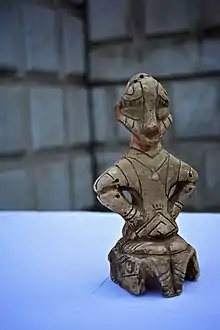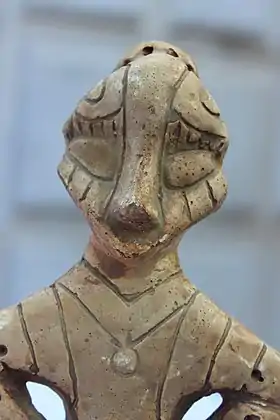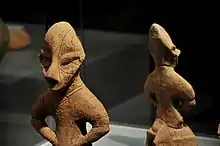Goddess on the Throne
Goddess on the Throne (Albanian: Hyjnesha në fron, Serbian: Богиња на трону, romanized: Boginja na tronu) is a terracotta figurine found at the site of the Tjerrtorja spinning mill in Pristina, the capital city of Kosovo,[lower-alpha 1] in 1956. The seated terracotta figure is a well-preserved specimen of small Neolithic plastic Vinča culture (also known as Turda culture or Turda-Vinča culture in Kosovo). It measures 18.5 cm high and is dated to 5700–4500 BC.[1]

The figurine represents a female deity, reflecting the cult of the great mother idol. It is preserved in the Kosovo Museum, which has adopted the idol as its logo. One of the most precious archaeological artifacts of Kosovo, it has also been adopted as the symbol of the city of Pristina.[2]
Gallery
External links
- The Goddess on the Throne Archived 2017-08-18 at the Wayback Machine
Annotations
- The political status of Kosovo is disputed. Having unilaterally declared independence from Serbia in 2008, it is formally recognised as an independent state by 97 UN member states (with another 15 recognising it at some point but then withdrawing recognition), while Serbia continues to claim it as part of its own sovereign territory.
References
- Goldsworthy, Adrian Keith; Haynes, Ian; Adams, Colin E. P. (1997). The Roman army as a community. Journal of Roman Archaeology. p. 100. ISBN 1887829342. Retrieved 2 March 2014.
- Berisha, Milot (2012) Archaeological Guide of Kosovo.- Ministry of Culture, Youth and Sport, Archaeological Institute of Kosovo, Prishtina, p.42 Last accessed 27 May 2016





